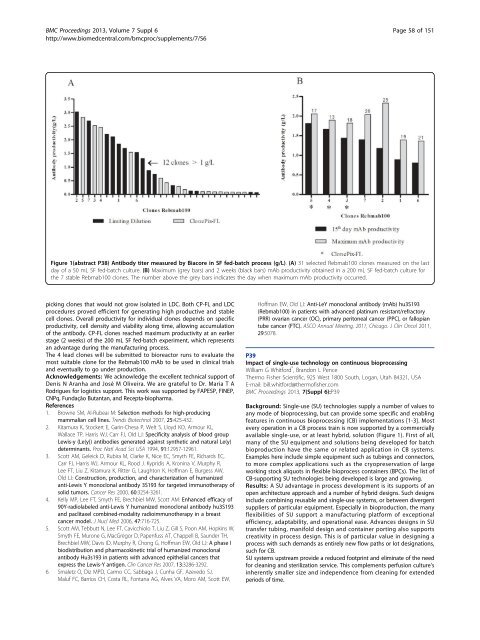Download PDF (all abstracts) - BioMed Central
Download PDF (all abstracts) - BioMed Central
Download PDF (all abstracts) - BioMed Central
You also want an ePaper? Increase the reach of your titles
YUMPU automatically turns print PDFs into web optimized ePapers that Google loves.
BMC Proceedings 2013, Volume 7 Suppl 6<br />
http://www.biomedcentral.com/bmcproc/supplements/7/S6<br />
Page 58 of 151<br />
Figure 1(abstract P38) Antibody titer measured by Biacore in SF fed-batch process (g/L). (A) 31 selected Rebmab100 clones measured on the last<br />
day of a 50 mL SF fed-batch culture. (B) Maximum (grey bars) and 2 weeks (black bars) mAb productivity obtained in a 200 mL SF fed-batch culture for<br />
the 7 stable Rebmab100 clones. The number above the grey bars indicates the day when maximum mAb productivity occurred.<br />
picking clones that would not grow isolated in LDC. Both CP-FL and LDC<br />
procedures proved efficient for generating high productive and stable<br />
cell clones. Over<strong>all</strong> productivity for individual clones depends on specific<br />
productivity, cell density and viability along time, <strong>all</strong>owing accumulation<br />
of the antibody. CP-FL clones reached maximum productivity at an earlier<br />
stage (2 weeks) of the 200 mL SF fed-batch experiment, which represents<br />
an advantage during the manufacturing process.<br />
The 4 lead clones will be submitted to bioreactor runs to evaluate the<br />
most suitable clone for the Rebmab100 mAb to be used in clinical trials<br />
and eventu<strong>all</strong>y to go under production.<br />
Acknowledgements: We acknowledge the excellent technical support of<br />
Denis N Aranha and José M Oliveira. WearegratefultoDr.MariaTA<br />
Rodrigues for logistics support. This work was supported by FAPESP, FINEP,<br />
CNPq, Fundação Butantan, and Recepta-biopharma.<br />
References<br />
1. Browne SM, Al-Rubeai M: Selection methods for high-producing<br />
mammalian cell lines. Trends Biotechnol 2007, 25:425-432.<br />
2. Kitamura K, Stockert E, Garin-Chesa P, Welt S, Lloyd KO, Armour KL,<br />
W<strong>all</strong>ace TP, Harris WJ, Carr FJ, Old LJ: Specificity analysis of blood group<br />
Lewis-y (Le(y)) antibodies generated against synthetic and natural Le(y)<br />
determinants. Proc Natl Acad Sci USA 1994, 91:12957-12961.<br />
3. Scott AM, Geleick D, Rubira M, Clarke K, Nice EC, Smyth FE, Richards EC,<br />
Carr FJ, Harris WJ, Armour KL, Rood J. Kypridis A, Kronina V, Murphy R,<br />
Lee FT, Liu Z, Kitamura K, Ritter G, Laughton K, Hoffman E, Burgess AW,<br />
Old LJ: Construction, production, and characterization of humanized<br />
anti-Lewis Y monoclonal antibody 3S193 for targeted immunotherapy of<br />
solid tumors. Cancer Res 2000, 60:3254-3261.<br />
4. Kelly MP, Lee FT, Smyth FE, Brechbiel MW, Scott AM: Enhanced efficacy of<br />
90Y-radiolabeled anti-Lewis Y humanized monoclonal antibody hu3S193<br />
and paclitaxel combined-modality radioimmunotherapy in a breast<br />
cancer model. J Nucl Med 2006, 47:716-725.<br />
5. Scott AM, Tebbutt N, Lee FT, Cavicchiolo T, Liu Z, Gill S, Poon AM, Hopkins W,<br />
Smyth FE, Murone G, MacGregor D, Papenfuss AT, Chappell B, Saunder TH,<br />
Brechbiel MW, Davis ID, Murphy R, Chong G, Hoffman EW, Old LJ: A phase I<br />
biodistribution and pharmacokinetic trial of humanized monoclonal<br />
antibody Hu3s193 in patients with advanced epithelial cancers that<br />
express the Lewis-Y antigen. Clin Cancer Res 2007, 13:3286-3292.<br />
6. Smaletz O, Diz MPD, Carmo CC, Sabbaga J, Cunha GF, Azevedo SJ,<br />
Maluf FC, Barrios CH, Costa RL, Fontana AG, Alves VA, Moro AM, Scott EW,<br />
Hoffman EW, Old LJ: Anti-LeY monoclonal antibody (mAb) hu3S193<br />
(Rebmab100) in patients with advanced platinum resistant/refractory<br />
(PRR) ovarian cancer (OC), primary peritoneal cancer (PPC), or f<strong>all</strong>opian<br />
tube cancer (FTC). ASCO Annual Meeting, 2011, Chicago. J Clin Oncol 2011,<br />
29:5078.<br />
P39<br />
Impact of single-use technology on continuous bioprocessing<br />
William G Whitford * , Brandon L Pence<br />
Thermo Fisher Scientific, 925 West 1800 South, Logan, Utah 84321, USA<br />
E-mail: bill.whitford@thermofisher.com<br />
BMC Proceedings 2013, 7(Suppl 6):P39<br />
Background: Single-use (SU) technologies supply a number of values to<br />
any mode of bioprocessing, but can provide some specific and enabling<br />
features in continuous bioprocessing (CB) implementations [1-3]. Most<br />
every operation in a CB process train is now supported by a commerci<strong>all</strong>y<br />
available single-use, or at least hybrid, solution (Figure 1). First of <strong>all</strong>,<br />
many of the SU equipment and solutions being developed for batch<br />
bioproduction have the same or related application in CB systems.<br />
Examples here include simple equipment such as tubings and connectors,<br />
to more complex applications such as the cryopreservation of large<br />
working stock aliquots in flexible bioprocess containers (BPCs). The list of<br />
CB-supporting SU technologies being developed is large and growing.<br />
Results: A SU advantage in process development is its supports of an<br />
open architecture approach and a number of hybrid designs. Such designs<br />
include combining reusable and single-use systems, or between divergent<br />
suppliers of particular equipment. Especi<strong>all</strong>y in bioproduction, the many<br />
flexibilities of SU support a manufacturing platform of exceptional<br />
efficiency, adaptability, and operational ease. Advances designs in SU<br />
transfer tubing, manifold design and container porting also supports<br />
creativity in process design. This is of particular value in designing a<br />
process with such demands as entirely new flow paths or lot designations,<br />
such for CB.<br />
SU systems upstream provide a reduced footprint and eliminate of the need<br />
for cleaning and sterilization service. This complements perfusion culture’s<br />
inherently sm<strong>all</strong>er size and independence from cleaning for extended<br />
periods of time.

















